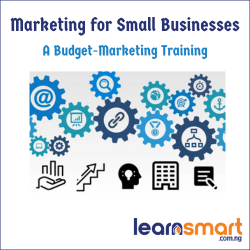
There aren’t many positives about doing business in a challenging economy. Business is tough, cash-flow is tight, and consumers rein in spending.
Thus many business leaders react accordingly. Anticipating reduced sales, they cut back on variable costs, including marketing, in order to deliver on their financial expectations.
It’s indeed expected that when business slows, you have to cut costs. But is marketing simply another expense, or is it an investment? Ask yourself this: if you stop marketing, how will you gain new business?
If you’re not moving forward, you’re moving backward. You need new business to grow. And one of the best ways to drive new business is to market. Even in a recession, people need goods and services. So you have to assume there are people out there who need your services but have never heard of you.
Another reason you must keep spending on marketing is that cutting marketing means cutting market share. The connection between share of market (SOM) and share of voice (SOV) has been proven. The higher your share of voice compared to your actual market share, the more likely your brand is to grow its market share in the subsequent year.
Organizations that cut back marketing in a challenging economy lose market share while those who continue to market gain market share at a lower cost.
Research has confirmed that the best strategy in terms of long-term Return On Investment (ROI) is even to increase marketing expenditure in a challenging economy. An analysis of the Profit Impact of Marketing Strategies (PIMS) database compared the results achieved by companies that increased, maintained, and reduced marketing spend during recession. Metrics used were Return on Capital Employed (ROCE) during the recession, ROCE during the first two years of recovery, and market share change during the same period of recovery.
While companies that cut marketing spend enjoyed superior ROCE during the recession, they achieved inferior results after the recession ended. During the recovery, the “spenders” achieved significantly higher return on capital employed and gained an additional 1.3 percentage points of market share.
What this also means is that marketing in a challenging economy can give you a competitive advantage. Your competition may be scared and cutting their marketing. But the smart organization who is able to see the light at the end of the tunnel and keeps investing in TOMA (top-of-mind awareness) will have a strong advantage. Now imagine you cut out marketing, but your competition didn’t.
Truth is, there are circumstances in which a business can’t help but cut back on marketing. However, the point here is that in those circumstances, your marketing budget shouldn’t be the first to go. Instead, you may need to get smarter about your marketing investment.
Reducing marketing is a negative movement and should be a last resort. Try cutting expenses elsewhere or shifting some of that marketing budget into alternative channels that might go a little further.
To conclude, in a challenging economy like we have today, you need to be looking to cut costs in every part of the business, but when it comes to marketing, it’s better to plan and spend. Otherwise, you will inadvertently be choosing to hide and go bust.
